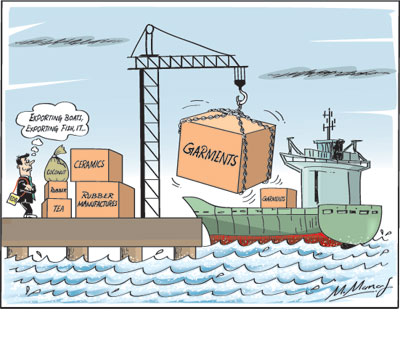Columns
Increasing traditional agricultural exports vital in national strategy
View(s):While the National Export Strategy (NES) to enhance exports in information technology services, boat building, tourism, new manufactures and several agricultural exports is commendable, the neglect of the three traditional agricultural exports would be a serious flaw in an export increasing strategy. The enhancement of tea, rubber and coconut production for export is also essential to boost exports.
 The country’s comparative advantage in agricultural exports must be exploited by increasing agricultural export surpluses, improving productivity and increasing value addition of agricultural exports. The neglect of tea, rubber and coconut production would be a serious error in economic thinking and policy.
The country’s comparative advantage in agricultural exports must be exploited by increasing agricultural export surpluses, improving productivity and increasing value addition of agricultural exports. The neglect of tea, rubber and coconut production would be a serious error in economic thinking and policy.
Parallel drive
While the NES to enhance exports is being implemented, there should be a parallel thrust to expand key agricultural exports. Production of tea, rubber and coconut should be increased to expand their export surpluses. Production of three crops has had setbacks and is below their potential.
Rubber
In the case of rubber, almost all the country’s rubber is used in manufactures, mainly for exports. While the value of natural rubber exports was only US$ 40 million, exports of rubber manufactures were US$ 835 million. This is a favourable development, but an increase in rubber production could generate a higher export surplus to earn significant export earnings.
Coconut
 Similarly coconut exports have decreased owing to reduced coconut production with the area under cultivation diminishing amid increased domestic consumption. As a large proportion of coconut produce is domestically consumed, coconut production has to be increased substantially to increase the export of coconut produce.
Similarly coconut exports have decreased owing to reduced coconut production with the area under cultivation diminishing amid increased domestic consumption. As a large proportion of coconut produce is domestically consumed, coconut production has to be increased substantially to increase the export of coconut produce.
Both natural rubber and coconut oil have a robust international demand. Therefore, generating export surpluses would benefit the country’s export earnings. The export strategy must not undervalue the importance of these agricultural exports. They have a high domestic value addition.
Importance
Agricultural exports have diminished in importance after the post-1980 diversification of the economy. Until then tea, rubber and coconut were the country’s main exports. They were also the mainstay of the economy. Since the 1980s, tea, rubber and coconut have diminished in importance owing to the increase in manufactured exports and due to sluggish production of these crops.
In 1977, as much as 80 percent of the country’s exports were agricultural produce. There was a sharp increase in manufactured exports from the 1980s. In 2017, manufactured exports accounted for 75 percent of total exports with agricultural exports amounting to only 24 percent of total exports.
Among agricultural exports, tea was by far the most important agricultural export in 2017. Tea exports were 13.5 percent, while natural rubber exports declined to as little as 0.3 percent and coconut exports to 3.1 percent of total exports last year.
Tea
There has been a lesser focus on the tea industry after the diversification of exports from the 1980s. In 2017, tea exports accounted for only 13.5 percent of exports, while industrial exports contributed 75 percent of total exports. Garments, the main manufactured export, accounted for 44 percent of total exports. These statistics have tended to consider tea as of lesser export significance.
Trade statistics deceptive
However, these statistics are deceptive and distort the importance of the tea industry. Tea production has a much larger domestic value addition than manufactured exports. It is estimated that the domestic value addition in tea is around 70 percent, while most manufactures, including garments, have a value addition of only about 30 percent. Therefore, the importance of tea exports is much higher than the export figures suggest. On the basis of domestic value addition, tea exports are the highest single merchandise export earner.
Misinterpretation
This interpretation of export values should not be taken as implying that manufactured exports are of not much significance. As pointed out in an earlier column, much of the future of Sri Lanka’s exports lie in contributing to value chains with low value addition. Countries that have advanced in exports have been those that have exported vast volumes of low value added commodities. This is the case with China, Vietnam, Malaysia, South Korea and Singapore.
Highest importance
It is important to realise that tea is of the highest importance for the country’s exports and the economy. Tea has been Sri Lanka’s highest export earner from the latter part of the nineteenth century and is still the country’s highest domestic value added export earner. Despite this importance of tea for the economy, the seventy post-independent years have been characterised by a neglect of the tea industry. Consequently, the country has lost its preeminent position in global tea production and exports, although it remains among the highest producers and exporters of tea.
Challenges in tea
A new resolve to enhance productivity and increase production of tea to increase exports could be of immense benefit to the economy. This is, however, a challenging task as much of the tea lands in the estates are senile and require replanting with high yielding vegetative propagated seedlings; there are severe labour shortages; inadequate replanting and under-planting; and research is underfunded.
Rubber
Similarly rubber cultivation on estates and smallholdings face severe problems that have to be met. The Rubber Master Plan that has been formulated has to be effectively implemented to achieve the expansion of natural rubber production. Expansion of the area under cultivation in new areas is an urgent need.
Coconut
The extent under coconut cultivation has to be expanded to increase coconut output significantly. The identification of the East and the North for extensive new cultivation is a move in the right direction. However development of coconut lands will take time. An increase in coconut exports is a medium and long term objective, but sooner it is begun the better.
Bottom-line
In the quest for increasing new avenues for increasing exports, there should not be a neglect of the country’s traditional agricultural exports. There must be also a serious effort to increase production of the country’s traditional agricultural exports.
These crops have high domestic value addition and a comparative advantage in international markets. Increasing their production and productivity is challenging but necessary. Let us not defer it or neglect it.


Leave a Reply
Post Comment